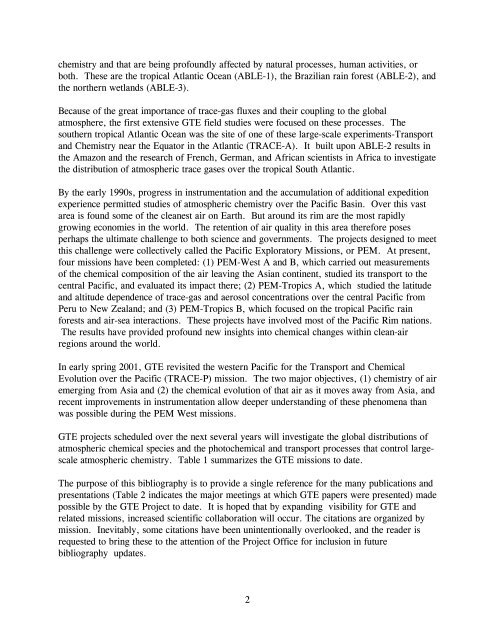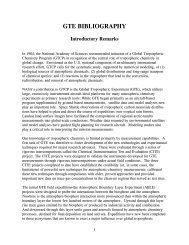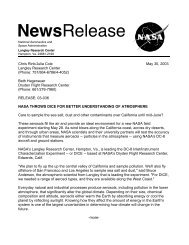Publications - GTE - NASA
Publications - GTE - NASA
Publications - GTE - NASA
Create successful ePaper yourself
Turn your PDF publications into a flip-book with our unique Google optimized e-Paper software.
chemistry and that are being profoundly affected by natural processes, human activities, or<br />
both. These are the tropical Atlantic Ocean (ABLE-1), the Brazilian rain forest (ABLE-2), and<br />
the northern wetlands (ABLE-3).<br />
Because of the great importance of trace-gas fluxes and their coupling to the global<br />
atmosphere, the first extensive <strong>GTE</strong> field studies were focused on these processes. The<br />
southern tropical Atlantic Ocean was the site of one of these large-scale experiments-Transport<br />
and Chemistry near the Equator in the Atlantic (TRACE-A). It built upon ABLE-2 results in<br />
the Amazon and the research of French, German, and African scientists in Africa to investigate<br />
the distribution of atmospheric trace gases over the tropical South Atlantic.<br />
By the early 1990s, progress in instrumentation and the accumulation of additional expedition<br />
experience permitted studies of atmospheric chemistry over the Pacific Basin. Over this vast<br />
area is found some of the cleanest air on Earth. But around its rim are the most rapidly<br />
growing economies in the world. The retention of air quality in this area therefore poses<br />
perhaps the ultimate challenge to both science and governments. The projects designed to meet<br />
this challenge were collectively called the Pacific Exploratory Missions, or PEM. At present,<br />
four missions have been completed: (1) PEM-West A and B, which carried out measurements<br />
of the chemical composition of the air leaving the Asian continent, studied its transport to the<br />
central Pacific, and evaluated its impact there; (2) PEM-Tropics A, which studied the latitude<br />
and altitude dependence of trace-gas and aerosol concentrations over the central Pacific from<br />
Peru to New Zealand; and (3) PEM-Tropics B, which focused on the tropical Pacific rain<br />
forests and air-sea interactions. These projects have involved most of the Pacific Rim nations.<br />
The results have provided profound new insights into chemical changes within clean-air<br />
regions around the world.<br />
In early spring 2001, <strong>GTE</strong> revisited the western Pacific for the Transport and Chemical<br />
Evolution over the Pacific (TRACE-P) mission. The two major objectives, (1) chemistry of air<br />
emerging from Asia and (2) the chemical evolution of that air as it moves away from Asia, and<br />
recent improvements in instrumentation allow deeper understanding of these phenomena than<br />
was possible during the PEM West missions.<br />
<strong>GTE</strong> projects scheduled over the next several years will investigate the global distributions of<br />
atmospheric chemical species and the photochemical and transport processes that control largescale<br />
atmospheric chemistry. Table 1 summarizes the <strong>GTE</strong> missions to date.<br />
The purpose of this bibliography is to provide a single reference for the many publications and<br />
presentations (Table 2 indicates the major meetings at which <strong>GTE</strong> papers were presented) made<br />
possible by the <strong>GTE</strong> Project to date. It is hoped that by expanding visibility for <strong>GTE</strong> and<br />
related missions, increased scientific collaboration will occur. The citations are organized by<br />
mission. Inevitably, some citations have been unintentionally overlooked, and the reader is<br />
requested to bring these to the attention of the Project Office for inclusion in future<br />
bibliography updates.<br />
2





